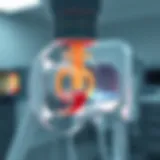Exploring Rare Diseases: Insights and Impact


Intro
Rare diseases, often overlooked in the broad spectrum of healthcare, present a unique set of challenges and complexities. These conditions, generally defined as those affecting fewer than 200,000 people in the United States, encompass a wide variety of medical issues, making them a niche yet significant field within medical research and practice. The low prevalence means that many of these diseases lack sufficient attention, funding, and research, often leaving those affected in a predicament with limited treatment options.
The difficulties faced by individuals diagnosed with rare diseases extend beyond mere health complications. These patients frequently battle for recognition, both regarding their condition and the necessity for tailored therapeutic approaches. This situation creates a ripple effect, influencing not only the patients but also their families, communities, and even the healthcare system at large.
Understanding rare diseases is essential not just for healthcare professionals but for researchers, policymakers, and society as a whole. As advances in genetic science and technology march forward, the potential for identifying and treating these illnesses grows. This article will explore various facets of rare diseases, emphasizing the importance of adequate research, advocacy, and awareness to improve the lives of those affected.
Overview of Research Topic
Brief Background and Context
The landscape surrounding rare diseases is akin to an intricate puzzle. Some conditions may be of genetic origin, while others might arise from environmental factors or infections. The diverse nature of these diseases lends itself to challenges in classification, as some conditions overlap or share symptomatic similarities. Notable examples include Wilson's disease, which affects copper metabolism, or Gorlin syndrome, a genetic disorder associated with various tumors.
The term "orphan diseases" often accompanies rare diseases, highlighting the lack of attention and resources directed toward them. Historically, pharmaceutical companies have been reluctant to invest in research and drug development due to the limited market size. Nonetheless, recent legislative efforts have aimed to incentivize the development of treatments for these conditions, indicating a shift in the scientific landscape.
Importance in Current Scientific Landscape
In today’s environment, rare diseases are gaining more visibility slowly. The rise of social media platforms like Facebook and Reddit allows patients and advocates to share their stories, thus raising awareness.
Moreover, understanding rare diseases is pivotal in the wider context of precision medicine, which seeks to tailor treatments to individual genetic profiles. The knowledge gained from researching rare conditions can produce insights beneficial to more common diseases, enabling doctors to devise innovative treatment strategies. As organizations and institutions worldwide increase their focus on rare disease research, the hope is to turn the tide for the millions affected by these conditions.
"The journey of studying rare diseases is not just about treating the illnesses, but rather understanding the people behind the conditions."
Methodology
Research Design and Approach
To explore this multifaceted topic, the research employed a mixed-methods approach. This involves a combination of qualitative and quantitative research, offering a comprehensive look into both the statistical prevalence of rare diseases and the personal experiences of patients. Surveys distributed to healthcare professionals and patients alike provide valuable quantitative data, while interviews give depth to the narrative.
Data Collection Techniques
Data collection for this exploration employed various techniques, including:
- Surveys: A wide-ranging questionnaire was circulated, targeting hospitals, clinics, and online patient support groups.
- Interviews: Conducted with healthcare professionals and patients, these discussions revealed real-world implications and experiences regarding diagnosis and treatment.
- Literature Review: Existing studies and papers were examined to contextualize findings and track the development of knowledge over time, including studies from sources such as Wikipedia and Britannica.
Using these approaches, the article aims to provide an exhaustive overview of the state of rare diseases today, spotlighting the importance of ongoing research and community involvement in enhancing the understanding and management of these complex conditions.
Intro to Rare Diseases
The world of healthcare is immense and varied, yet within it lies a subset that often escapes the public eye: rare diseases. This section serves as a gateway to understanding these conditions that, while less common, carry significant consequences. With the rise of global health awareness, it’s imperative to shed light on rare diseases, their characteristics, and their impact on individuals and society. Knowing about these ailments helps clarify why research, advocacy, and education are crucial areas of focus.
Definition and Importance
A rare disease is typically defined as a condition that affects a small percentage of the population, often fewer than 200,000 individuals in the U.S. or 1 in 2,000 individuals in the European Union. These diseases present unique challenges not only for those directly affected, but also for healthcare systems and researchers. Understanding the definition lays the groundwork for comprehending the broader implications.
Importantly, the rarity of these diseases often results in underdiagnosis or misdiagnosis. These patients can feel lost in a sea of medical terminology and often fall through the cracks of mainstream healthcare. The importance of recognizing and addressing rare diseases lies in fostering a more compassionate and effective medical community, one willing to take the extra step to understand the complexities of human health.
Global Prevalence Statistics
Globally, it's estimated that there are over 7,000 rare diseases affecting approximately 400 million people worldwide. This staggering number represents a diverse group of conditions, ranging from genetic disorders like cystic fibrosis to rare cancers. Various organizations, like the National Organization for Rare Disorders, keep track of these figures to emphasize the need for targeted research and treatment options.
"Many people believe that rare diseases are just that—rare. Every patient story, however, adds to a collective experience that highlights the diversity and urgency within this field."
While a disease might be classified as 'rare', its effects can be far-reaching, creating an unseen burden on families and caregivers and imposing significant economic challenges. In countries with healthcare systems that rely on research and development for innovations, the rarity of these diseases can stifle advancements, as there is often limited funding allocated to their study.
The journey into understanding rare diseases begins here, paving the way for future sections of this article, which will tackle classifications, symptoms, impacts, and research advancements that can lead to effective solutions for those afflicted.
Classification of Rare Diseases
Classifying rare diseases is like attempting to solve a complicated puzzle with scattered pieces. Proper classification is not just a mere academic exercise; it plays a crucial role in understanding these conditions, developing treatments, and addressing the needs of patients and their families. By categorizing rare diseases, we can identify commonalities among them, discern patterns in their prevalence, and ultimately craft focused research and advocacy strategies. This section delves into the significance of classification, with a spotlight on hereditary versus acquired conditions, as well as specific disease categories that encompass a variety of conditions.
Hereditary vs. Acquired Conditions
When we talk about rare diseases, we often encounter a distinction between hereditary and acquired conditions. Hereditary diseases are genetically passed down from parents to offspring. An occurrence of such diseases in a family can be traced through generations, highlighting the importance of understanding familial health histories. On the flip side, acquired diseases emerge due to environmental factors, infections, or lifestyle choices, and don't necessarily show up in family histories.
Recognizing this classifcation is essential for several reasons. For one, treatments and management strategies can differ significantly based on whether a disease is hereditary or acquired. Hereditary disorders, like muscular dystrophy, often require genetic counseling and perhaps interventions aimed at modifying gene expression. In contrast, addressing an acquired condition may emphasize lifestyle changes or treatment of underlying infections. Moreover, the psychological impacts differ vastly; understanding the root causes informs how families approach these diseases emotionally and socially.
Specific Disease Categories
In the sprawling world of rare diseases, we can also categorize them into specific condition groups. Each category brings with it unique characteristics and nuances that influence its management and research directions. Here are some key categories worth exploring:


Metabolic Disorders
Metabolic disorders present a fascinating area within rare diseases. They arise from abnormalities in biochemical processes, leading to an imbalance of essential substances in the body. Take Phenylketonuria (PKU) as an example; it’s a genetic disorder where the body cannot properly process phenylalanine, an amino acid found in many protein-rich foods. This condition's uniqueness stems from its necessary dietary restrictions, which can vastly change a patient's quality of life.
The interesting aspect of metabolic disorders is how early detection can pave the way for effective management. Newborn screening programs help in identifying such disorders, allowing infants to begin treatment right away. However, these disorders can be challenging, as many have severe long-term health implications if undiagnosed.
Neurological Disorders
When diving into neurological disorders, the complexity increases significantly. Conditions such as Alexander Disease represent a range of rare, progressive disorders that primarily affect the brain and its functioning. The hallmark of neurological disorders is that they impact not just the afflicted individual, but the family as well, as they often involve lifelong care considerations. The key characteristic here is how these disorders can manifest in multiple ways, from cognitive decline to motor difficulties.
One unique feature of neurological disorders is the variability in symptoms, which can change over time; what may be a minor issue today could escalate significantly tomorrow. Thus, continuous monitoring and a flexible approach in management are critical, as supportive care may shift depending on the patient's progression and needs.
Rare Cancers
The category of rare cancers reflects a pressing need for increased awareness. These cancers, such as Merkel cell carcinoma, occur so infrequently that many healthcare professionals remain unaware of them, leading to late diagnosis. A salient characteristic of rare cancers is their unpredictability; treatment protocols can be vastly different than those for more common cancers due to a lack of extensive clinical trial data.
The unique aspects of rare cancers often highlight the need for specialized treatment centers with expertise in handling such cases. Moreover, the emotional gravitational pull that these diagnoses carry can be particularly heavy for patients and families due to their rarity and often poor prognosis. Advocacy for research and increased funding for trials becomes vital in this area to discover more effective treatments and improve survivorship outcomes.
Immunological Diseases
Immunological diseases represent another diverse and vital category. These diseases occur when the body’s immune system fails to function correctly, resulting in its attack on healthy tissues, otherwise known as autoimmune diseases. Adenosine Deaminase Deficiency, for example, is an exceptionally rare immunological disorder that can lead to severe combined immunodeficiency.
A major key characteristic of these diseases is their complex and often unpredictable nature. Unlike other rare diseases, immunological disorders are frequently misdiagnosed due to overlapping symptoms with more common illnesses. This misdiagnosis not only leads to delays in treatment but also increases the emotional and financial strain on affected families. Therefore, clear classification helps in ensuring a path toward appropriate diagnosis and effective therapy.
Understanding the classifications of rare diseases unveils a multifaceted landscape rife with challenges and opportunities. By exploring hereditary versus acquired conditions and diving into specific disease categories, we can enhance our grasp of these intricate health conditions and advocate for better research, treatment, and support.
Symptoms and Diagnosis
Symptoms and diagnosis play a pivotal role in understanding the landscape of rare diseases. While these conditions affect only a small fraction of the population, their complexities can be overwhelming for patients, families, and healthcare professionals alike. Recognizing the symptoms early can significantly influence the course of treatment and improve the quality of life for those affected. By exploring this section, readers can appreciate the myriad ways symptoms manifest, along with the barriers that hinder timely, accurate diagnosis.
Common Symptoms in Rare Diseases
Identifying symptoms associated with rare diseases can often feel like searching for a needle in a haystack due to their diversity. Many of these symptoms overlap with more common ailments, leading healthcare practitioners down a winding path of misdirection. Take, for example, symptoms like chronic fatigue or joint pain; these are often dismissed as merely being due to stress or a viral infection. In truth, they can herald a more serious underlying condition. Here’s an outline of noteworthy symptoms:
- Fatigue: A frequent red flag across numerous rare diseases.
- Pain: Presenting in various forms, from mild discomfort to severe pain, often localized in certain regions.
- Skin Changes: Rashes or unusual pigmentation that can hint at genetic conditions.
- Respiratory Issues: Such as chronic cough or wheezing, common in diseases like cystic fibrosis.
- Neurological Symptoms: Including seizures, developmental delays, or coordination issues that may signal disorders such as Huntington’s disease.
The broad spectrum of symptoms complicates the search for diagnosis. Each symptom might point to a different ailment, and thus, it’s crucial for medical professionals to consider the full clinical picture and engage in thorough evaluations.
Challenges in Diagnosis
Diagnosing rare diseases is often akin to piecing together a puzzle with missing pieces. Medical practitioners and patients frequently confront several challenges that collectively contribute to this difficulty.
Misdiagnosis
Misdiagnosis is a significant hurdle in the realm of rare diseases. Often, symptoms are attributed to more common conditions, leading to inappropriate treatments and wasted time. A person with Gaucher disease may initially be treated for arthritis due to persistent joint pain, delaying access to the right care. This mischaracterization can become a cycle where patients endure unnecessary tests and therapies that provide no real relief.
- The key characteristic of misdiagnosis is its reliance on statistical commonality. When symptoms align with those of prevalent illnesses, rare conditions often fall off the radar.
- Because of this, it’s essential for both parties—patients advocating for themselves and physicians—to remain vigilant and skeptical of initial assessments.
- Misdiagnosis, while frustrating, can become a beneficial focal point in this article by showing the critical need for heightened awareness of rare diseases among healthcare providers.
Delayed Diagnosis
Delayed diagnosis can be a double-edged sword, often resulting in a prolonged health struggle for the patient. Symptoms can linger or worsen, creating unneeded health complexities.
- A hallmark of delayed diagnosis is the extended period, sometimes years, that patients endure before receiving a definitive answer. For instance, many individuals with amyotrophic lateral sclerosis experience a long journey through various specialists, only to eventually discover the true nature of their condition.
- This lengthiness complicates not just treatment but also emotional well-being, as uncertainty can weigh heavily on individuals and families.
- Highlighting delayed diagnosis presents a chance to advocate for the development of better screening practices and awareness campaigns.
Diagnostic Testing Limits
The limitations in diagnostic testing can add another layer of difficulty in identifying rare diseases. Because these conditions affect so few individuals, there is often less research and fewer resources devoted to developing comprehensive tests.
- A key characteristic of diagnostic testing limits is the lack of specific tests for many rare diseases. Many rely on elimination of other conditions rather than on direct testing, which can be inefficient.
- This lack of specificity not only impacts diagnosis times but can also lead to misinformed treatment strategies, putting patients at risk of receving inappropriate care.
- Recognizing these limits allows this article to address the vital need for investment in research and the pursuit of tools that can enhance diagnostic capabilities for the less common and less understood diseases.
"Diagnosing rare diseases often requires a keen eye and open mind—an intersection of medical skill and patient advocacy."
In summary, the landscape of symptoms and diagnosis in rare diseases is fraught with complication, yet understanding these elements is crucial for progress. For both patients and healthcare providers, navigating this terrain can lead to improved outcomes through education and advocacy.
Impact of Rare Diseases
The significance of understanding the impact of rare diseases cannot be overstated. While each rare disease may individually affect a small number of people, collectively, they encompass a substantial portion of the population. Recognizing the implications of these diseases on patients, families, and society at large is crucial for fostering awareness, advancing research, and improving treatments.
Patient and Family Perspectives
From the viewpoint of individuals grappling with rare diseases, the journey is often fraught with challenges. Those affected frequently experience feelings of isolation, as many people, including friends and even healthcare providers, might be unaware of their condition. This lack of understanding can lead to a sense of hopelessness, as patients are often left in the dark about their prospects.
Families play a fundamental role in the experience of rare diseases. They face not only emotional strain but also practical issues such as navigating healthcare systems. Medical professionals may not immediately recognize the symptoms due to their rarity, which can lead to lengthy diagnostic odysseys filled with uncertainty. Some families recount tales of consulting numerous specialists before they finally receive a correct diagnosis. The emotional toll can impact relationships, leading to increased stress and even financial difficulties stemming from ongoing medical expenses.


"Living with a rare disease is like walking through fog; you often can't see what's ahead, and every step is uncertain."
The effort of patient advocacy groups, who work tirelessly to spread awareness and support individuals, is of utmost importance. These organizations provide resources and build communities for sharing information about rare diseases, giving families a platform to voice their challenges and victories alike. They foster a sense of belonging, something vital for those facing the daunting nature of rare diseases.
Economic and Social Implications
The economic ramifications of rare diseases extend beyond the individual. The costs associated with research, treatment, and care for patients can stretch resources thin, resulting in significant economic burdens on healthcare systems. It may seem surprising, but the investment in developing drugs for rare diseases can be disproportionately high compared to common ailments.
Consider the R&D costs: developing a treatment can range into millions of dollars, requiring long-term funding commitments from both governmental and private sectors. As outlined in a study published by the National Institutes of Health, for every rare disease treatment, the expenses often outweigh the potential market returns, leading pharmaceutical companies to be reluctant in investing in such ventures.
Socially, the stigma attached to rare diseases can alienate individuals, leading to psychological impacts. There's a need for greater public education and awareness campaigns to diminish misinformation and stereotypes surrounding these diseases. By promoting understanding and acceptance, communities can become more supportive, resulting in improved quality of life for those affected.
In summary, the impact of rare diseases reaches far beyond the individual level. It influences families emotionally and economically, while also placing a burden on healthcare resources. A collective effort towards advocacy, education, and continued research is essential in transforming lives and ultimately paving the way for greater understanding of rare diseases.
Prominent Rare Diseases
Rare diseases may be few and far between, but their impact is significant, both for those directly affected and for society as a whole. Understanding prominent diseases like cystic fibrosis, Huntington's disease, amyotrophic lateral sclerosis (ALS), and Gaucher disease not only sheds light on the unique challenges faced by patients but also highlights the importance of ongoing research and advocacy. Each of these conditions presents its own set of symptoms, treatment approaches, and social implications, making it crucial to explore a detailed understanding of these diseases. By focusing on these key examples, we gain insight into the broader spectrum of rare diseases, fostering awareness and inspiring action.
Cystic Fibrosis
Cystic fibrosis (CF) is a genetic disorder that primarily affects the lungs and digestive system. The culprit here is a mutation in the CFTR gene, leading to thick, sticky mucus that can clog airways and lead to devastating respiratory issues. Patients with CF often face chronic lung infections and progressive lung damage.
Key points about Cystic Fibrosis:
- Symptoms usually manifest in early childhood, with children often showing difficulty in breathing, poor growth, and frequent coughing.
- Life expectancy has improved over recent decades due to advances in treatment, but challenges remain in the form of maintaining lung function.
- Current Treatments: New medications, such as modulators that target the underlying genetic defect, are changing treatment perspectives.
"Today’s advancements in gene therapy bring a glimmer of hope to the CF community, paving pathways that were once deemed impossible."
Huntington's Disease
Huntington's disease is an unpredictable, heritable condition caused by a genetic mutation that leads to the progressive degeneration of nerve cells in the brain. An individual’s chances of inheriting this disease is high if a parent has it, typically appearing around middle age.
Significant aspects of Huntington's Disease:
- Symptoms include motor dysfunctions, cognitive decline, and psychiatric issues, severely affecting daily life.
- There's no cure yet, but research focuses on delaying symptoms or even halting disease progression.
- Social and Emotional Impact: The awareness of potential inheritance can strain families emotionally, demanding robust support systems.
Amyotrophic Lateral Sclerosis
Amyotrophic lateral sclerosis (ALS), often referred to simply as Lou Gehrig's disease, is a neurological condition that affects motor neurons, eventually leading to muscle weakness and atrophy. The exact cause remains a puzzle, though genetic factors may contribute.
Understanding ALS:
- Symptoms usually begin with muscle twitching and weakness, gradually impairing all voluntary muscles.
- Current treatments focus on symptomatic relief rather than a cure, which underscores the need for further research.
- Patient Experience: The experience of patients and their caregivers is often a struggle against a relentless progression of the disease.
Gaucher Disease
Gaucher disease is a metabolic disorder resulting from inadequate levels of an enzyme called glucocerebrosidase. This deficiency causes fatty substances to build up in various organs, particularly the spleen, liver, and bone marrow.
Insight into Gaucher Disease:
- Symptoms can vary widely, including enlargement of the spleen and liver, bone pain, and fatigue.
- Treatment options include enzyme replacement therapy, which can help manage symptoms effectively.
- Diverse Phenotypes: Awareness that Gaucher is not a one-size-fits-all condition is crucial for appropriate diagnosis and therapy.
Current Research and Developments
In the continuously evolving field of medicine, research and development concerning rare diseases offers a glimpse into the potential for innovative solutions. Understanding the latest advancements is crucial for students, researchers, educators, and professionals aiming to make headway in this domain. Insights gleaned from current studies not only provide hope for those affected but also help map the future of therapeutic interventions, making this area of exploration vital.
Innovations in Treatment Approaches
Gene Therapy
Gene therapy stands out as a groundbreaking strategy in treating rare diseases, aiming to directly modify the genes responsible for the disease. The key characteristic of gene therapy is its focus on the root cause rather than merely alleviating symptoms. By delivering correct copies of genes to replace defective ones or to functionally compensate for missing genes, it could lead to lasting benefits for patients.
One unique feature of this treatment is its ability to be tailored for specific genetic mutations, which is often the essence of many rare diseases. The primary advantage of gene therapy is the potential for a one-time treatment to provide a lifelong remedy. However, challenges remain, such as the cost of therapies and potential adverse reactions, which can complicate patient access and scalability in clinical settings.
Stem Cell Research
Stem cell research is another promising avenue that holds significant promise for rare disease treatment. The core aspect of stem cells is their unique ability to develop into different cell types, thus offering a way to regenerate damaged tissues or organs. This adaptability makes stem cell therapy a valuable choice for numerous rare, often degenerative conditions.
The key characteristic of stem cell therapy is its potential for repair and regeneration, allowing for the hope of functional restoration in affected areas. A notable advantage is the versatility of stem cells; they can be harvested from various sources such as bone marrow, fat tissue, or even from induced pluripotent stem cells (iPSCs). Nonetheless, this approach also faces hurdles like ethical concerns over stem cell sourcing and varying degrees of effectiveness, demanding continuous research and refinement.
Precision Medicine


Precision medicine embodies a tailored approach to disease treatment by taking into account individual differences in genetics, environment, and lifestyle. Its significance in rare diseases cannot be overstated, especially as therapies can be customized based on the genetic makeup of individual patients.
Highlighting its adaptability, precision medicine allows health professionals to deliver interventions that are more likely to work effectively for specific patient populations. This individualized approach not only enhances treatment efficacy but also minimizes the risks of adverse reactions. Yet, the unique feature of precision medicine is its dependency on extensive genomic understanding, which can be resource-intensive and influence the pace of research and application in clinical practice.
Clinical Trials and Studies
Clinical trials play an essential role in the advancement of treatment options for rare diseases. They serve as a backbone for evidence-based medicine, allowing researchers to scrutinize the effectiveness and safety of innovative therapies. However, participants in such trials often face challenges related to recruitment due to the low prevalence of many rare diseases.
Effective strategies in this realm include:
- Global collaboration: Engaging multiple research centers and health organizations can enhance the scope and reach of clinical trials.
- Patient registries: These can help identify potential candidates for studies, facilitating a smoother recruitment process.
- Inclusive criteria: Expanding eligibility for trials to attract a broader patient demographic helps overcome low enrollment numbers.
Overall, the landscape of research in rare diseases is vibrant and continually evolving. While innovations like gene therapy, stem cell research, and precision medicine pave the way for new treatment methods, clinical trials remain a necessary instrument for validating these advances.
Advocacy and Awareness
Advocacy and awareness play a pivotal role in addressing the challenges surrounding rare diseases. Understanding these facets is essential as they not only enhance the visibility of these conditions but also drive crucial changes in medical research, assist in better patient support systems, and influence policies that affect those living with rare diseases. By raising awareness, communities can foster an environment where rare diseases are not viewed as anomalies but recognized for their complexities and the real implications they have on individuals and families. The benefits from such advocacy efforts are multi-fold, and they are becoming increasingly important in the scientific landscape.
Role of Advocacy Groups
Advocacy groups serve as lifelines for patients and their families. They form a bridge that connects affected individuals with resources, knowledge, and emotional support. The importance of these organizations can be distilled into several key functions:
- Education: Advocacy groups often provide educational materials and resources to help patients and caregivers better understand a specific rare disease. This knowledge is crucial for navigating treatment options and recognizing symptoms.
- Lobbying for Change: Many advocacy groups engage in lobbying efforts aimed at influencing policymakers. They push for funding allocations for research, drug development, and improved health care policies that directly impact those diagnosed with rare conditions.
- Community Building: These groups foster a sense of community among patients and their families. They organize events, forums, and networking opportunities that allow individuals to connect, share stories, and uplift one another in their journeys.
- Raising Funds for Research: Advocacy organizations often spearhead fundraising efforts to finance research studies and trials. They create campaigns that not only bring in financial support but also raise awareness about specific diseases.
From conducting awareness campaigns to organizing support groups, advocacy organizations are instrumental in altering the landscape of rare diseases, ensuring that affected individuals and their families are not left in the shadows.
Raising Public Awareness
Public awareness is the linchpin in the fight against rare diseases. When the community at large understands the impact and magnitude of these conditions, it leads to several critical outcomes:
- Increased Research Funding: More awareness often translates into more funding for research. When the public recognizes the significance and prevalence of rare diseases, they are likely to support initiatives and funding drives, encouraging researchers and pharmaceutical companies to devote resources toward treatment solutions.
- Support for Patients: When awareness is heightened, it naturally creates a more supportive environment for those affected. Families tend to find empathy from others and are more likely to receive assistance from healthcare providers who are informed about symptoms and management strategies.
- Collaboration Among Stakeholders: Increased public awareness facilitates collaboration between various stakeholders such as researchers, policymakers, and healthcare providers. This cooperation can lead to new initiatives aimed at addressing the myriad of challenges associated with diagnosing and treating rare diseases.
- Empowerment: A well-informed public means empowered patients. Greater awareness gives individuals the confidence to take charge of their health, engage in discussions with healthcare professionals, and advocate for their needs in medical settings.
"Raising awareness about rare diseases is not just a noble endeavor; it's a necessity that can lead to genuine transformations in lives affected by these conditions."
Future Directions in Rare Disease Research
Understanding the trajectory of rare disease research is crucial, particularly in a landscape marked by rapid medical advancements. Engaging with this area not only aligns with the biological and clinical significance of such conditions but also emphasizes the need for persistent inquiry and innovation. As a canvas painted with complexities, future directions in research offer a beacon of hope for those directly impacted by these diseases, as well as maintain a focus on the broader implications for society and healthcare systems.
The exploration of new methodologies, technologies, and collaborative approaches can make considerable strides in diagnosis, treatment, and patient care for rare diseases. This research segment holds substantial promise, primarily focusing on enhancing patient outcomes and offering insights that could change the narrative surrounding rare health conditions.
Emerging Trends
In the realm of rare disease research, emerging trends often correlate with cutting-edge advancements in science and technology. Some specific trends that stand out include:
- Personalized Medicine: Tailoring medical treatment to the individual characteristics of each patient is becoming more common. Researchers are harnessing genetic profiling to ensure that therapies are as effective as possible.
- Artificial Intelligence (AI): AI's potential in handling vast data sets has not gone unnoticed. By employing algorithms to identify patterns, researchers can accelerate the discovery of potential new therapies or diagnostics.
- Collaborative Networks: An uptick in partnerships among academic institutions, biotech companies, and advocacy groups fosters a more dynamic research environment. This collaborative spirit often leads to pooling resources and sharing valuable insights.
Despite these promising trends, researchers remain vigilant of the hurdles inherent in rare disease studies.
Challenges Ahead
Looking ahead, several challenges still demand attention in the realm of rare disease research:
- Funding Limitations: Rare diseases often lack the financial backing seen in more common conditions. This scarcity leads to inadequate support for necessary research initiatives.
- Limited Patient Populations: The small number of patients can complicate clinical trials, making it difficult to gather statistically significant data to support findings or interventions.
- Data Sharing Regulations: While collaboration is crucial, navigating the regulations surrounding the sharing of medical data can pose barriers to cooperative research efforts.
These obstacles can seem daunting. However, tackling them is essential for progress.
"Overcoming the challenges present in rare disease research requires ingenuity and determination, standing as a testament to human resilience, innovation, and collaboration."
By addressing these emerging trends and challenges, the future of rare disease research can evolve in a direction that not only addresses the needs of patients but also transforms the understanding and management of these diseases, paving the way toward more effective treatments and enhanced quality of life.
Closure
In light of the extensive exploration of rare diseases throughout this article, the conclusion serves a critical role in synthesizing key insights while also emphasizing the importance of these conditions within the broader medical narrative. Rare diseases, often overlooked, affect millions around the globe, and their complexity demands attention not only from the scientific community but also from society as a whole. Understanding these diseases illuminates their multifaceted nature, ranging from genetic origins to environmental factors and social implications.
Summary of Key Insights
The journey through this article has provided a multifaceted understanding of rare diseases. Key insights include:
- Definition and Classification: Rare diseases are not merely uncommon; they encompass a spectrum of disorders, from hereditary conditions to those acquired through environmental exposure. Such classifications aid in targeted research and treatment strategies.
- Symptoms and Diagnosis: The presentation of symptoms can often vary widely, making diagnosis a complex task. Misdiagnosis remains a persistent issue that needs addressing to improve patient outcomes.
- Impact: The weight of rare diseases significantly shapes not just the lives of those directly affected but their families and communities as well. Economic implications and emotional strain often come hand in hand, which necessitates a robust response from healthcare systems.
- Advocacy and Research Efforts: The engagement of advocacy groups and the promotion of public awareness play significant roles in driving research funding and influencing policy decisions.
By compiling these insights, a cohesive understanding emerges, demonstrating how rare diseases not only challenge individuals and health systems but also compel a deeper dive into societal attitudes towards health and medical conditions.
Call to Action for Research and Support
The necessity for further research and robust support systems cannot be overstated. As it stands, many rare diseases still lack effective treatment options, with countless patients facing daily struggles that could be alleviated through better understanding and innovation in solutions.
To bolster efforts in tackling these challenges, the following steps are crucial:
- Increased Funding: More funding needs to flow into research specifically targeting rare diseases. Governments and private organizations must collaborate to facilitate the discovery of new treatment modalities and potential cures.
- Public Awareness Campaigns: Raising awareness within the general populace can pave the way for enhanced understanding and empathy. Awareness can drive more individuals into advocacy roles, fostering a community that pushes for legislative changes favorable to rare disease research.
- Collaboration Among Stakeholders: Collaboration among researchers, medical practitioners, and patients is imperative for meaningful progress. Such partnerships can yield innovative approaches to treatment and care.



